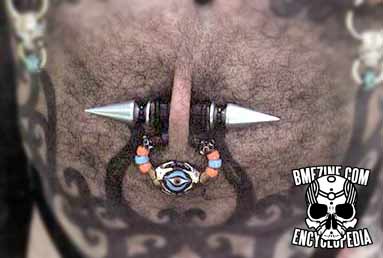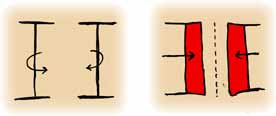Bipedicle Flap
A bipedicle flap (technically a tubed pedicle flap in this case) procedure allows a "handle" to be created coming off of the body. In reconstructive surgery this tissue is then removed and used to rebuild other parts of the body (flap surgery dates back as far as 600 BC — see the entry on earlobe reconstruction history for more on that), but in body modification of the type BME covers, the tubed bipedicle ("with two feet") flap is the end goal in and of itself. The photo below shows one located just below the sternum.
Simply put: To create a bipedicle flap, incisions are made on each side of the future flap. Half of this tissue is rolled under and connected to form the flap, and the other half is connected underneath to form the base of the tunnel under the flap.
Most bipedicle flaps in this context are "random flaps", meaning that they obtain their blood supply from capillaries rather than named arteries (if they don't get enough blood, the tissue can become necrotic). In addition, these flaps are generally only skin (in a medical context, fascia, muscle, and other tissue may also be included, depending on the purpose of the flap). For amputees who wear prosthetics limbs, bipedicle flaps that go through muscle groups of the remainder of the limb are often used to secure the prosthetic as well as make it functional (by controlling the muscle group with the flap, the patient can bend the false limb).
Naturally, this is a surgical procedure and should be treated as such. Realistically, most people would not be prepared or qualified to perform this on themselves.

